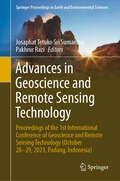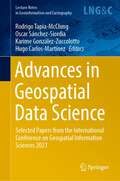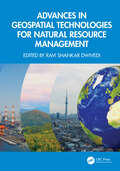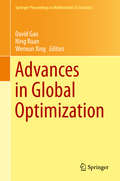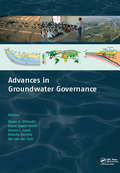- Table View
- List View
Advances in Geoscience and Remote Sensing Technology: Proceedings of the 1st International Conference of Geoscience and Remote Sensing Technology (October 28-29, 2023, Padang, Indonesia) (Springer Proceedings in Earth and Environmental Sciences)
by Josaphat Tetuko Sri Sumantyo Pakhrur RaziThis book comprises works presented in the 1st International Conference of Geoscience, Remote Sensing, and Technology, which was held in Padang, Indonesia, in October 2023. It was hosted by the Center of Disaster Monitoring and Earth Observation, State University of Padang, Indonesia. Included are works related but not limited to geoscience, remote sensing, radar SAR, optic satellites, LiDAR, earthquakes, drones, geophysics, computer science, computer engineering, information technology, and mapping.
Advances in Geospatial Data Science: Selected Papers from the International Conference on Geospatial Information Sciences 2021 (Lecture Notes in Geoinformation and Cartography)
by Rodrigo Tapia-McClung Oscar Sánchez-Siordia Karime González-Zuccolotto Hugo Carlos-MartínezThis book presents a selection of manuscripts submitted to the 2nd International Conference on Geospatial Information Sciences 2021, a virtual conference held on November 3-5, 2021. These papers were selected by the Scientific Program Committee of the Conference after a rigorous peer-review process. They represent the vast scope of the interdisciplinary research areas that characterize the Geospatial Information Sciences that is done in the discipline. It especially represents a fabulous opportunity to showcase research carried out by young Mexican researchers and showcase it to the rest of the world and enhance the growth of the sciences in the country while, at the same time, enforces them to level up with other research at the international level.
Advances in Geospatial Technologies for Natural Resource Management
by Ravi Shankar DwivediTimely and reliable information on natural resources, regarding their potential and limitations, is a prerequisite for sustainable development. Geospatial technologies offer immense potential in providing such information in a timely and cost-effective manner. Using orbital sensors data in conjunction with airborne and proximal sensors data to generate information on soils and agricultural resources, forests, mineral resources, fossil fuel, wetlands, water resources, and marine resources, this book focuses on the advancements in technologies applicable to managing these resources. It addresses global issues like climate change and land degradation neutrality and introduces spatial data infrastructure (SDI) as a mechanism for sharing geospatial data. This book also provides an in-depth discussion on drones, crowdsourcing, cloud computing, Internet of Things, machine learning, and their applications.FEATURES Contains a comprehensive resource on the latest developments in geospatial technologies and their use in monitoring natural resources, productivity mapping, and modeling Explains the geo-computation methods and online algorithm developments Includes clear guidance on how best to use geospatial data for various applications Discusses case studies from a variety of fields and current trends in the management of natural resources Provides future scenarios concerning platforms, sensors, data analysis, and interpretation techniques This book is written for remote sensing and GIS professionals in environmental institutions and government who are involved in natural resource management projects. Senior undergraduate and graduate-level students in Earth sciences, geography, or environmental management can also use this text for supplementary reading.
Advances in Geospatial Technology in Mining and Earth Sciences: Selected Papers of the 2nd International Conference on Geo-spatial Technologies and Earth Resources 2022 (Environmental Science and Engineering)
by Xuan-Nam Bui Long Quoc Nguyen Luyen Khac Bui Ha Thanh TranThis book composes the proceedings of the international conference on Geo-Spatial Technologies and Earth Resources (GTER 2022) which was co-organized by Hanoi University of Mining and Geology and the International Society for Mine Surveying (ISM) held at Hanoi city on October 13–14, 2022.GTER 2022 is technically co-sponsored by Vietnam Mining Science and Technology Association (VMST), Vietnam Association of Geodesy, Cartography and Remote Sensing (VGCR), Vietnam National Coal-Mineral Industries Holding Corporation Limited (VINACOMIN), and the Dong Bac Corporation (NECO).GTER 2022 aims to bring together experts, researchers, engineers, and policymakers to discuss and exchange their knowledge and experiences in recent geospatial technologies, advances in mining and earth sciences.
Advances in Geosynthetics Engineering: Proceedings of the 2nd GeoMEast International Congress and Exhibition on Sustainable Civil Infrastructures, Egypt 2018 – The Official International Congress of the Soil-Structure Interaction Group in Egypt (SSIGE) (Sustainable Civil Infrastructures)
by Erol Guler Mohamed Meguid J. P. GiroudThis volume contains contributions on advances in geosynthetics engineering. Soil reinforcement is a very useful technique to construct several cost-effective soil structures in an environmentally friendly and sustainable manner. The most commonly used reinforcement materials are galvanised steel strips, geosynthetics in the form of woven geotextiles, geogrids and geocomposites, and fibres from natural and waste products. In recent years, there have been advances in the area of soil reinforcement, especially in the utilization of the technique in field projects. The researchers have also been working to understand the behaviour of reinforced soil considering the field challenges of reinforced soil structures. The volume is based on the best contributions to the 2nd GeoMEast International Congress and Exhibition on Sustainable Civil Infrastructures, Egypt 2018 – The official international congress of the Soil-Structure Interaction Group in Egypt (SSIGE).
Advances in Geotechnical Engineering & Geoenvironmental Engineering: Proceedings of the 6th GeoChina International Conference on Civil & Transportation Infrastructures: From Engineering to Smart & Green Life Cycle Solutions -- Nanchang, China, 2021 (Sustainable Civil Infrastructures)
by Jinfeng Wang Shanzhi Shu Mena SoulimanThis book includes a collection of researches that contains research data, discussions and conclusions focusing on several related geotechnical aspects of infrastructure. Topics include issues related to civil infrastructure such as temperature-induced lateral earth pressure on bridge abutment, subsidence of high speed rail and expressway, application of recycled rubber mats, railway ballast evaluation, hurricane protection floodwall, tunnel portal stability, deep excavation case study and properties of contaminated soils. Various types of research were used in the various studies, including field measurements, numerical analyses and laboratory measurements. This findings and results should lead to more resilient infrastructure design, maintenance and management, which will provide benefits to both civil engineering practitioners, researchers and students
Advances in Geotechnical and Transportation Engineering: Select Proceedings of FACE 2019 (Lecture Notes in Civil Engineering #71)
by Sireesh Saride B. Umashankar Deepti AvirneniThis book presents the selected peer-reviewed papers from the national conference Futuristic Approaches in Civil Engineering (FACE) 2019. This volume focuses on latest research and challenges in the field of geotechnical, transportation, environmental and water resources engineering. The first part focuses on alternative and sustainable pavement materials, maintenance and rehabilitation of roads, transportation planning, traffic engineering, hybrid vehicles, safety management, and intelligent transport systems. In the second part of the book, basic and advanced research in geotechnical engineering which can provide sustainable solutions to practical problems in foundations, retaining structures, soil dynamics, site characterization, slope stability, dams, rock engineering, environmental geotechnics, and geosynthetics are covered. The third part of the book includes current research in environment, and water resources engineering. The contents of this book will be useful for students, researchers as well as industry professionals.
Advances in Geotechnics and Structural Engineering: Select Proceedings of TRACE 2020 (Lecture Notes in Civil Engineering #143)
by Sanjay Kumar Shukla J. Bhattacharjee Sudharshan N. Raman Bishwajit BhattacharjeeThis book comprises select proceedings of the International Conference on Trends and Recent Advances in Civil Engineering (TRACE 2020). The book focuses on the latest research developments in structural engineering, structural health monitoring, rehabilitation and retrofitting of structures, geotechnical engineering, and earthquake-resistant structures. The contents also cover the latest innovations in building repair and maintenance, and sustainable materials for rehabilitation and retrofitting. The contents of this book are useful for students, researchers, and professionals working in structural engineering and allied areas.
Advances in Geriatric Dermatology
by Anne Lynn S. ChangThis concise, easy-to-read book summarizes the current clinical evidence and basic science relating to aging and the skin, assisting the clinician in addressing skin problems in older dermatologic patients. Each chapter focuses on a particular area in which new knowledge has rapidly emerged over the past 5 years, ensuring that the book is completely up-to-date. Recent insights into aging skin from basic and translational science are first discussed, covering the underlying genetics and the potential role of topical agents and procedures in reversing the aging process. Evidence-based prescribing in older patients is then explained, and the evidence relating to treatments for psoriasis, reviewed. Further chapters in Geriatric Dermatology address non-surgical treatment options for basal cell carcinoma, the increase in and management of sexually transmitted diseases in older dermatology patients, and cutaneous signs of elder mistreatment. Case vignettes and informative illustrations assist the reader in quickly grasping the connection between an age-related process and its clinical impact. Geriatric Dermatology is written for dermatologists, research scientists with translational interest, geriatricians, and gerontologists.
Advances in Geroscience
by Felipe Sierra Ronald KohanskiThis book provides the first comprehensive overview of a new scientific discipline termed Geroscience. Geroscience examines the molecular and cellular mechanisms that might explain why aging is the main risk factor for most chronic diseases affecting the elderly population. Over the past few decades, researchers have made impressive progress in understanding the genetics, biology and physiology of aging. This book presents vital research that can help readers to better understand how aging is a critical malleable risk factor in most chronic diseases, which, in turn, could lead to interventions that can help increase a healthy lifespan, or 'healthspan. ' The book begins with an analysis of the Geroscience hypothesis, as well as the epidemiological underpinnings that define aging as a candidate main risk factor for most chronic diseases. Next, each chapter focuses on one particular disease, or group of diseases, with an emphasis on how basic molecular and cellular biology might explain why aging is a major risk factor for it. Coverage in the book includes: cancer, cardiovascular disease, dementias, stroke, Parkinson's and Alzheimer's diseases, osteoporosis, arthritis, diabetes asthma, emphysema, kidney disease, vision impairment, and AIDS/HIV. It finishes with a chapter on pain in the elderly and an overview of future steps needed to bring the newly acquired knowledge into the clinic and the public at large.
Advances in Glass Research
by Shadia Jamil IkhmayiesThis book covers preparation methods, characterization, and applications of most glass families. It reports the fundamentals of glass, challenges in the development, traditional and new manufacturing processes, characterization techniques, structural, thermal, and optical properties. The book reviews redox reactions in glasses and the factors affecting them, in addition to the techniques for determining the redox states and speciation of polyvalent ions in glass. A special chapter is dedicate to phosphate glasses, their importance, preparation methods, structure and properties. The use of different types of phosphate glasses in biomedicine, optics, electrochemistry, and as hosts for nuclear wastes is thoroughly discussed. Moreover, the applications of phosphate glasses in electronics and laser technology are also discussed in this book. <p><p> Recent experimental studies such as the development of a novel bioglass system and the influence of ZnO, TiO2, and Al2O3 incorporation on structural, mechanical strength, degradation, pH variation, and formation of hydroxyapatite (Hap) layer on the glass surface are reported. Promising aluminum-silicate glassy system and its glass-ceramic counterpart are also presented in this books. An overview of the calorimetry approaches related to rare earth improvements on the thermal stability of glass is provided. The book discusses the advances in the chalcogenide glasses (ChGs) and based devices. It also reports their applications in optical devices, semiconductor circuits, and other applications. In addition, lanthanide and/or QDs doped luminescent glasses and their use in solid-state lighting and displays, security (anti-counterfeiting), optical temperature sensors, and solar energy (solar spectrum conversion) are reviewed along with a comparison of their advantages and disadvantages. Finally, the nature of phthalocyanines as materials for glass coatings and most widely used synthesis methods of porphyrins and phthalocyanines are discussed.
Advances in Glass and Glass-Ceramics: Proceedings of International Conference on Advances in Glasses and Glass-Ceramics 2022 (Springer Proceedings in Materials #46)
by J. M. Parker Atiar R. Molla Annapurna KalyandurgThis book presents select proceedings of International Conference on Advances in Glasses and Glass-ceramics (ICAGGC 2022). The year 2022 was declared as the International Year of Glass and this timely volume marks the importance of glass to achieve a more equitable and sustainable world. Various topics covered in this volume include structure and properties of glass, simulation and modelling on glass, glass/glass-ceramics for biomedical applications, glass for photonic applications, glass for energy and environment, multifunctional glass and glass-ceramics, and manufacturing and processing of glass. The book will be useful for researchers and professionals working in the field of materials science, especially glass.
Advances in Global Marketing: A Research Anthology
by Leonidas C. Leonidou Constantine S. Katsikeas Saeed Samiee Bilge AykolThis book of expert contributions provides a comprehensive analysis of contemporary global marketing issues under different international business settings. It covers a wide array of key areas of international marketing research such as cross-cultural consumer behavior, foreign market entry modes, international entrepreneurship, international marketing strategy, country-of-origin effects, internationalization process, international buyer-seller relationships, corporate social responsibility, and international marketing performance. With both theoretical and empirical contributions by prominent researchers from all over the world, the book highlights and advances extant knowledge on global marketing and offers recommendations for future research. It builds a useful reference for scholars, doctoral researchers, and senior students in international marketing/business.
Advances in Global Optimization: In Honor Of Gilbert Strang (Springer Proceedings in Mathematics & Statistics #95)
by David Gao Ning Ruan Wenxun XingThis proceedings volume addresses advances in global optimization--a multidisciplinary research field that deals with the analysis, characterization and computation of global minima and/or maxima of nonlinear, non-convex and nonsmooth functions in continuous or discrete forms. The volume contains selected papers from the third biannual World Congress on Global Optimization in Engineering & Science (WCGO), held in the Yellow Mountains, Anhui, China on July 8-12, 2013. The papers fall into eight topical sections: mathematical programming; combinatorial optimization; duality theory; topology optimization; variational inequalities and complementarity problems; numerical optimization; stochastic models and simulation and complex simulation and supply chain analysis.
Advances in Glycobiotechnology (Advances in Biochemical Engineering/Biotechnology #175)
by Udo Reichl Erdmann RappThis book reviews the latest trends in glycobiotechnology, it offers an authoritative discussion about future directions of glycoengineering, and it provides a comprehensive overview about the current and emerging approaches to identify, quantify and characterize glycosylated proteins.Divided into 14 chapters, the book outlines recombinant glycoprotein expression in mammalian cells, insect cells, yeast, and bacterial systems. It covers the chemical and enzymatic syntheses of glycans and glyconjugates, and addresses the impact of glycosylation on protein function for the development of biologicals including vaccines. In the final chapters of the book, readers will discover more about the state-of-the-art in glycomics, glycoproteomics and glycan array technologies.
Advances in Graphic Communication, Printing and Packaging Technology and Materials: Proceedings of 2020 11th China Academic Conference on Printing and Packaging (Lecture Notes in Electrical Engineering #754)
by Min Xu Li Yang Pengfei Zhao Zhuangzhi Ye Linghao Zhang Rengao ZhuThis book includes a selection of reviewed papers presented at the 11th China Academic Conference on Printing and Packaging, held on November 26–29, 2020, Guangzhou, China. The conference is jointly organized by China Academy of Printing Technology and South China University of Technology. With 10 keynote talks and 200 presented papers on graphic communication and packaging technologies, the conference attracted more than 300 scientists.The proceedings cover the recent findings in color science and technology, image processing technology, digital media technology, mechanical and electronic engineering and numerical control, materials and detection, digital process management technology in printing and packaging, and other technologies. As such, the book is of interest to university researchers, R&D engineers and graduate students in the field of graphic arts, packaging, color science, image science, material science, computer science, digital media, network technology and smart manufacturing technology.
Advances in Graphic Communication, Printing and Packaging: Proceedings of 2018 9th China Academic Conference on Printing and Packaging (Lecture Notes in Electrical Engineering #543)
by Min Xu Li Yang Yun Ouyang Pengfei Zhao Yuhui RenThis book includes a selection of reviewed papers presented at the 9th China Academic Conference on Printing and Packaging, which was held in November 2018 in Shandong, China. The conference was jointly organized by the China Academy of Printing Technology and Qilu University of Technology (Shandong Academy of Sciences). With 8 keynote talks and over 200 presented papers on graphic communication and packaging technologies, the conference attracted more than 300 scientists.The proceedings cover the recent findings in color science and technology, image processing technology, digital media technology, mechanical engineering and numerical control, materials and detection, digital process management technology in printing and packaging, and other technologies. As such, the book is of interest to university researchers, R&D engineers and graduate students in the field of graphic arts, packaging, color science, image science, material science, computer science, digital media, and network technology.
Advances in Green Energies and Materials Technology: Selected Articles from the Algerian Symposium on Renewable Energy and Materials (ASREM-2020) (Springer Proceedings in Energy)
by Younes Chiba Abdelhalim Tlemçani Arezki SmailiThis book presents selected articles from the Algerian Symposium on Renewable Energy and Materials (ASREM-2020) held at Médéa, Algeria. It highlights the latest advances in the field of green energies and material technology with specific accentuation on numerical plans and recent methodologies designed to solve engineering problems. It includes mathematical models and experimental measurements to study different problems in renewable energy and materials characterization, with contributions from experts in both academia and industry, and presents a platform to further collaborations in this important area.
Advances in Green Energy Systems and Smart Grid: First International Conference On Intelligent Manufacturing And Internet Of Things And 5th International Conference On Computing For Sustainable Energy And Environment, Imiot And Icsee 2018, Chongqing, China, September 21-23, 2018, Proceedings, Part Iii (Communications In Computer And Information Science #925)
by Kang Li Qun Niu Zhile Yang Jianhua Zhang Minyou ChenThe three-volume set CCIS 923, CCIS 924, and CCIS 925 constitutes the thoroughly refereed proceedings of the First International Conference on Intelligent Manufacturing and Internet of Things, and of the 5th International Conference on Intelligent Computing for Sustainable Energy and Environment, ICSEE 2017, held in Nanjing, China, in September 2017.The 135 revised full papers presented were carefully reviewed and selected from over 385 submissions.The papers of this volume are organized in topical sections on: clean energy; electric vehicles; energy saving; energy storages; power system analysis.
Advances in Green Energy Technologies: Proceedings of ICGEST 2023, Volume 2 (Lecture Notes in Electrical Engineering #1314)
by Anupam Dewan Rajesh Kumar Shelly VadheraThe book constitutes proceedings of the International Conference on Green Energy and Sustainable Technology, ICGEST 2023. The book covers research in energy management, planning the operation of renewable energy systems, distributed generation and energy management, economics/ electricity market and policy/ regulatory aspects, data analytics & AI applications in smart grid. This book contains research papers from academicians, researchers as well as students. This book is a valuable resource for students, academics, and practitioners in the industry working on energy areas.
Advances in Green Synthesis: Avenues and Sustainability (Advances in Science, Technology & Innovation)
by Inamuddin Anish Khan Mohd Imran Ahamed Rajender BoddulaThis edited book focusses on green chemistry as the research community endeavours to create eco-friendly materials and technologies. It provides an in-depth overview of the fundamentals, key concepts and experimental techniques for eco-friendly synthesis of organic compounds and metal/metal oxide nanoparticles/nanomaterials. It also emphasizes the mechanisms, designing and industrial technologies for green synthesis and its applications. Each chapter brings the recent developments, state of the art, challenges and perspectives which cover all the aspects in one place, and which concern the green synthesis and evolution. Authored by world-renowned experts in a broad range of green chemistry sectors, this book is an archival reference guide for researchers, engineers, scientists and postgraduates working in the field of sustainable science, green chemistry, environmental science, engineering sciences and industrial technologies.
Advances in Greener Energy Technologies (Green Energy and Technology)
by Karma Sonam Sherpa Akash Kumar Bhoi Akhtar Kalam Gyoo-Soo ChaeThis book presents ongoing research activities of currently available renewable energy technologies and the approaches towards clean technology for enabling a socio-economic model for the present and future generations to live in a clean and healthy environment. The book provides chapter wise implementation of research works in the area of green energy technologies with proper methods used with solution strategies and energy efficiency approaches by combining theory and practical applications. Readers are introduced to practical problems of green computation and hybrid resources optimization with solution based approaches from the current research outcomes. The book will be of use to researchers, professionals, and policy-makers alike.
Advances in Groundwater Governance
by Karen G. Villholth Alberto Garrido Elena Lopez-Gunn Kirstin Conti Jac Van Der GunThis book addresses groundwater governance, a subject internationally recognized as crucial and topical for enhancing and safeguarding the benefits of groundwater and groundwater-dependent ecosystems to humanity, while ensuring water and food security under global change. The multiple and complex dimensions of groundwater governance are captured in 28 chapters, written by a team of leading experts from different parts of the world and with a variety of relevant professional backgrounds. The book aims to describe the state-of-the-art and latest developments regarding each of the themes addressed, paying attention to the wide variation of conditions observed around the globe. The book consists of four parts. The first part sets the stage by defining groundwater governance, exploring its emergence and evolution, framing it through a socio-ecological lens and describing groundwater policy and planning approaches. The second part discusses selected key aspects of groundwater governance. The third part zooms in on the increasingly important linkages between groundwater and other resources or sectors, and between local groundwater systems and phenomena or actions at the international or even global level. The fourth part, finally, presents a number of interesting case studies that illustrate contemporary practice in groundwater governance. In one volume, this highly accessible text not only familiarizes water professionals, decision-makers and local stakeholders with groundwater governance, but also provides them with ideas and inspiration for improving groundwater governance in their own environment.
Advances in Group Psychotherapy: Living in the Passionate Bad Fit (ISSN)
by Stewart L. AledortAdvances in Group Psychotherapy presents an exploration of the work of Stewart Aledort in group psychotherapy.The book covers key areas of Aledort’s work in group psychotherapy, including theory and working with shame, anger, and aggression in the group. It includes theoretical and clinical cases from Aledort’s work throughout, as well as new interviews which explore his most well-known theories. The book also explores Aledort’s retirement from practice, with interviews exploring how he ended his group work after more than five decades.Advances in Group Psychotherapy will be of great interest to all group psychotherapy and group analysis practitioners in practice and in training.
Advances in Group Therapy Trauma Treatment (AGPA Group Therapy Training and Practice Series)
by Leonardo M. Leiderman Bonnie J. BucheleAdvances in Group Therapy Trauma Treatment contains compelling theoretical, clinical, and research advances in group trauma therapy by leading experts in the field. This timely book includes short-term integrated and long-term psychodynamic group therapy models from several theoretical perspectives, with informative clinical illustrations in each chapter describing how to foster co-regulation of affect, treat disturbances in attachment, and address dissociation, shame, primitive defenses, and enactments associated with PTSD, complex PTSD, and sexual abuse. Interventions to address the harm and loss of safety following mass trauma that are often mirrored in large and small psychotherapy groups are described. Unique to this volume is the role of diversity, the necessary adaptations of group therapy models to different cultures, and the relationship of trauma to structural and systemic racism, hate, and bigotry. Finally, leadership considerations such as training, ethical guidelines, supervision, pre-group preparation, and self-care for group therapists will be enumerated. Integrating well-established group theory and techniques with new practice and research findings, this book is indispensable to mental health professionals who treat traumatized individuals.
